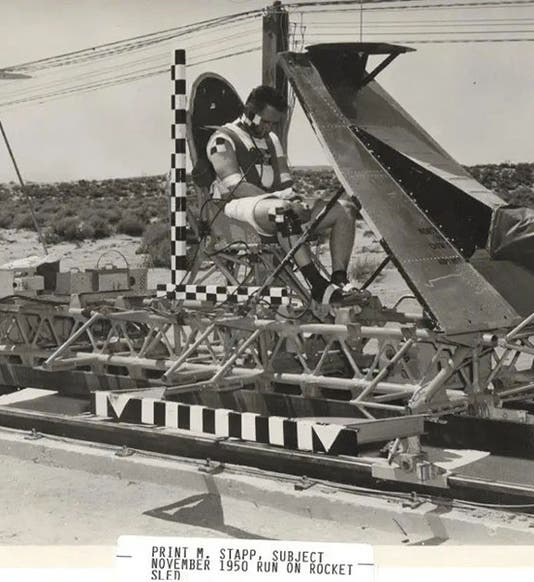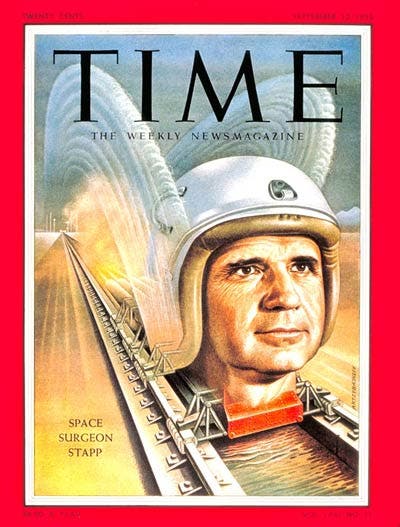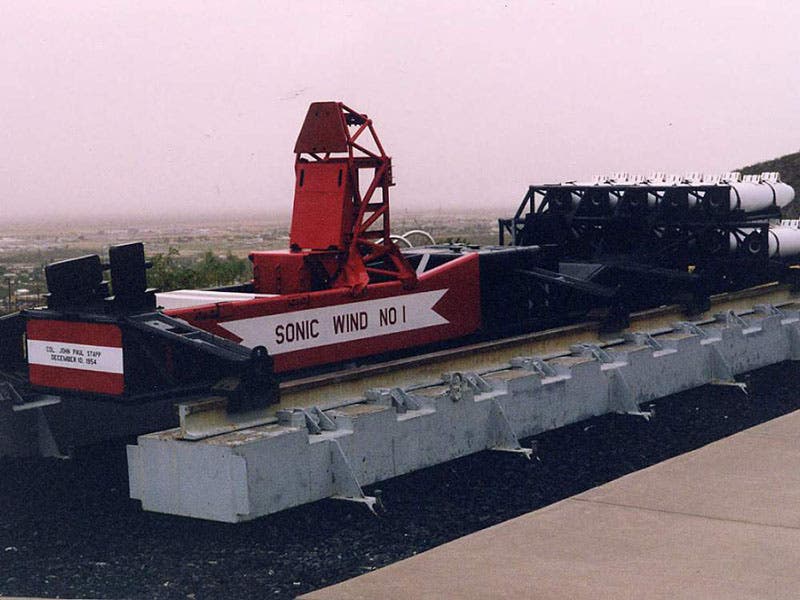Scientist of the Day - John Paul Stapp
John Paul Stapp, an American physician and pioneer in aerospace medicine, died Nov. 13, 1999, at the age of 89. Stapp was a flight surgeon in the U.S. Army Air Forces at the end of World War II, continued in the field of aviation medicine after the war, and transferred to the U.S. Air Force when it was established in 1947, to continue his work on the human response to flight. He was interested from the beginning in the limits of the human body when subjected to the increasing forces provided by faster and faster aircraft. In the early 1950s, no one knew what humans could withstand when it came for g-forces, rapid spins, oxygen deprivation, and exposure to cosmic rays. Stapp began a program of human testing to determine those limits, becoming chief of the Aeromedical Field Laboratory at Holloman Air Force Base, New Mexico. Many ingenious tests were done on Air Force personnel volunteers, but when it came to g-forces, he decided to experiment on himself. Conventional wisdom held that g-forces higher than 18 (18 times the force of gravity) would be fatal. Stapp had a rocket sled designed that would accelerate him down a track at high speed and then run into a trough of water and come to an almost immediate stop, subjecting his body to great deceleration force (first image). Stapp showed early on that the 18 g barrier was entirely fictitious. When he passed 38 g, he was told by his superiors to desist. He did, eventually, but not before one last ride, just before Christmas, 1954, when his redesigned sled rocketed to over 630 mph and then stopped in 1.3 seconds, subjecting Stapp to a force of over 46 g. He temporarily lost his vision, and he had two black eyes and two cracked wrists to show for the stress, but he was otherwise fine. He had shown, as he was always trying to demonstrate, that the human body is capable of surviving much more abuse than we give it credit for. He had also gone faster than any human being on Earth, and for that, he appeared on the cover of Time Magazine on Sep. 12, 1955 (second image).
Stapp was also interested in learning how humans would survive at high altitude, and in space. At that time (1955), the Air Force had no interest whatsoever in space, since pilots did not go into space. So Stapp had to turn to balloons for his experiments. Theoretically, a balloon could rise to 100,000 feet and carry a human with it, where all sorts of tests could be done, since, unlike a plane that might breach that barrier for a few seconds, the balloon could stay there for 24 hours or more. Stapp started Project Manhigh to send a human as far into the stratosphere as he could. He had a minuscule budget, and no support from higher management, but all three Manhigh ascents were successful in spite of some equipment malfunctions, and all reached over 96,000 feet in altitude. And for Manhigh I, Stapp discovered Joseph Kittinger, test pilot turned high altitude balloonist, who in 1960, would not only reach 102,000 feet on a Project Excelsior ascent, but would step out and fall for 85,000 feet and 13 minutes before opening his parachute and descending safely to earth.
Stapp pretty much had aerospace medicine to himself until 1957. But then Sputnik went up, NASA was established in 1958 and given control of the space race, and the Air Force was told to stay out of the business, a business that it had never wanted to be in anyway, except for Stapp. So Stapp never got the credit he deserved for being a real pioneer in the American space program. When NASA wondered how to pick its first 7 astronauts, it turned to Stapp, who had already worked through all this for Project Manhigh, and his physical tests were used to select the Mercury 7. But otherwise. Stapp was left outside the field that he, almost single-handedly, had created.
There is an excellent “American Experience” program, first aired in 2016, that looks at all aspects of Stapp’s career. It is called “Spacemen,” and you can find it here, but I think you might have to be a PBS subscriber to view it. The sled that Stapp rode to his g-record in 1954, Sonic Wind no. 1, may be seen and climbed on at the New Mexico Museum of Space History in Alamogordo, New Mexico (fourth image). Note the NINE solid-fuel rockets that provided the boost Stapp needed to reach his world record speed, before his eye-popping deceleration.
Dr. William B. Ashworth, Jr., Consultant for the History of Science, Linda Hall Library and Associate Professor emeritus, Department of History, University of Missouri-Kansas City. Comments or corrections are welcome; please direct to ashworthw@umkc.edu.









